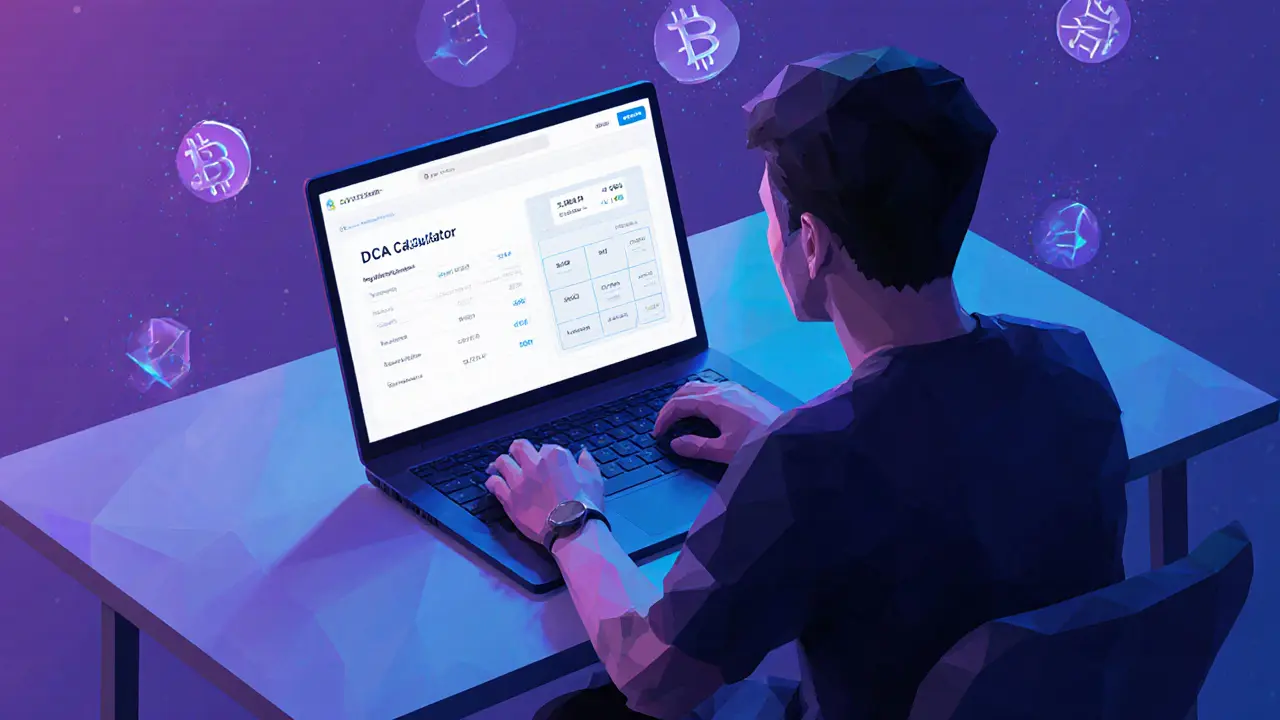Dollar‑Cost Averaging While HODLing: A Practical Crypto Investment Playbook
 Feb, 18 2025
Feb, 18 2025
Crypto DCA Calculator
Investment Summary
Trying to grow a crypto portfolio without getting caught up in daily price spikes feels impossible, right? What if you could automate purchases, ignore the hype, and still end up with a solid position over years? That’s exactly what Dollar‑Cost Averaging while HODLing is a hybrid approach that merges regular crypto buys with a long‑term hold mindset promises. Below you’ll find a step‑by‑step guide, real‑world numbers, and pitfalls to watch out for - all without needing a PhD in market timing.
Key Takeaways
- Buy a fixed dollar amount of crypto on a set schedule, regardless of price.
- Hold every purchase indefinitely - no selling during dips or rallies.
- The method smooths out volatility, often lowering your average cost basis.
- Automation removes emotional decisions and cuts down on time spent tracking markets.
- In strong bull runs, lump‑sum investing may beat this approach, but the gap narrows over long horizons.
What Exactly Is the Strategy?
Dollar‑Cost Averaging (or DCA) is the practice of investing a set sum of money at regular intervals - weekly, bi‑weekly, or monthly - no matter where the market stands. It originated in traditional finance and migrated to crypto as platforms added recurring‑buy features.
HODLing, a slang term short for “hold on for dear life,” is the opposite of frequent trading. When you HODL, you keep every coin you acquire for the long haul, trusting that over years the asset’s value will rise.
Put them together, and you get a disciplined system: you never miss a purchase, and you never sell. The two concepts reinforce each other - DCA handles the timing, HODLing handles the exit strategy (or lack thereof).
How the Mechanics Play Out
Let’s walk through a concrete example. Imagine you have $50,000 earmarked for Bitcoin. You decide on five equal purchases of $10,000 each, spaced six months apart.
- First purchase: Bitcoin sits at $50,000 → you acquire 0.20BTC.
- Second purchase: price drops to $45,000 → you get 0.222BTC.
- Third purchase: a steep dip to $25,000 → you pick up 0.400BTC.
- Fourth purchase: price stays at $25,000 → another 0.400BTC.
- Fifth purchase: a rally to $55,000 → you collect 0.182BTC.
Adding it up, you own 1.404BTC at an average cost of about $35,600 per coin, instead of just 1BTC at $50,000 if you had invested the whole sum outright. That lower cost basis can be a big boost when prices climb again.
Why It Beats Lump‑Sum and Active Trading (Most of the Time)
Traditional lump‑sum investing means you dump all your cash into a crypto asset at once. If you buy right before a crash, you’re stuck with a steep loss. DCA spreads the risk - you buy some at highs, some at lows, and the average cost tends to smooth out.
Active traders chase short‑term price moves, which demands constant monitoring, technical analysis, and nerves of steel. Studies from Coinbase and Fidelity show that most retail traders underperform the market over long periods. By automating purchases, you remove emotion from the equation - no panic‑selling when Bitcoin slides 20% and no greed‑driven buying at unsustainable peaks.
That said, during a runaway bull market that lasts for several years, a full‑front lump‑sum can capture the entire upside earlier, potentially outperforming DCA. The trade‑off is risk: DCA protects you from timing errors, while lump‑sum maximizes upside at the cost of higher exposure to a possible crash.

Setting Up Your DCA‑HODL Plan
All major exchanges - Coinbase, Binance, Kraken, and even newer DeFi‑friendly platforms - now let you schedule recurring buys. Here’s a quick checklist:
- Choose your asset(s). Bitcoin and Ethereum dominate, accounting for roughly 70% of total market cap. Their deep liquidity makes automated purchases cheap.
- Pick a frequency. Align it with your cash flow - weekly if you get a salary, bi‑weekly if you freelance.
- Set the amount. Keep it realistic; $100‑$500 per purchase works for most retail investors.
- Enable auto‑rebalancing (optional). Some platforms let you keep a target allocation (e.g., 80% Bitcoin, 20% Ethereum) and will shift new funds to maintain that split.
- Review quarterly. Adjust the dollar amount if your income changes, but don’t tinker with the schedule frequently.
Once configured, the exchange will deduct the amount from your linked bank or wallet and execute the order at the market price. No manual clicks required.
Common Pitfalls and How to Stay Disciplined
Even a set‑and‑forget system can be tripped up by psychology.
- Skipping purchases during crashes. It’s tempting to wait for a “clearer” price. Remember, DCA’s power lies in buying *more* when prices dip.
- Scaling up during a frenzy. If Bitcoin shoots up 30% in a week, you might feel the urge to add more cash. Stick to the preset amount - otherwise you’re back to market‑timing.
- Ignoring fees. Repeated small buys can rack up transaction costs on some platforms. Look for exchanges that offer fee‑free recurring buys or low maker fees.
- Tax blind spots. Frequent purchases generate many taxable events. Use tax‑optimization tools that aggregate the cost basis across all DCA transactions.
One practical tip is to set up a separate “crypto bucket” in your budgeting app. Transfer a fixed sum into that bucket each payday, then let the exchange pull from the bucket. This visual separation makes it harder to skip a purchase.
Future Trends: Automation, DeFi, and Tax Tools
As of 2024, exchanges are rolling out sophisticated scheduling options - think “buy the dip” triggers, auto‑rebalancing, and even integration with decentralized finance (DeFi) protocols that let you earn yield on newly bought coins without moving them off‑exchange.
Imagine a smart contract that pulls $100 from your wallet every two weeks, swaps it for Ethereum on a DEX, and stakes it in a liquidity pool instantly. That’s the next frontier for DCA‑HODL enthusiasts.
Tax‑reporting software is also catching up. By aggregating every DCA transaction, these tools can calculate average cost basis using FIFO, LIFO, or specific‑identification methods, saving you from manual spreadsheets.
Quick Comparison: DCA vs Lump‑Sum Investing
| Aspect | DCA (Recurring Buy) | Lump‑Sum |
|---|---|---|
| Risk of timing error | Low - spreads purchases over time | High - all capital exposed at entry |
| Emotional involvement | Minimal after automation | High - markets can cause panic or greed |
| Potential upside in strong bull market | Moderate - missed early gains | High - captures full upward move |
| Average cost basis | Often lower due to buys at dips | Fixed at entry price |
| Required effort | One‑time setup + periodic review | One‑time investment, no follow‑up |
Frequently Asked Questions
Can I use DCA with altcoins like Solana or Cardano?
Absolutely. The same recurring‑buy logic works for any coin that your exchange lists. Just watch out for higher fees on low‑volume altcoins and make sure the platform supports automated purchases for that asset.
How often should I re‑balance my DCA portfolio?
If you’ve set a target allocation (e.g., 70% Bitcoin, 30% Ethereum), a quarterly review is usually enough. Some platforms handle auto‑rebalancing for you, which removes the need for manual checks.
Do I need a special wallet for DCA?
No. Most exchanges let you link a bank account or debit card directly. If you prefer non‑custodial storage, you can set up a regular transfer to your own wallet after each purchase, but that adds a manual step.
Will DCA protect me from a total crypto crash?
DCA reduces the impact of any single price swing, but it can’t stop a market‑wide collapse. Your exposure still depends on how much you allocate overall.
Is there a tax advantage to DCA?
Not directly. However, spreading purchases can make it easier to track cost basis and may smooth out large taxable events, especially when paired with dedicated tax‑software.
Bottom line: If you want a low‑maintenance way to build crypto wealth while keeping emotions at bay, marrying Dollar‑Cost Averaging with HODLing is a solid play. Set it up, forget it, and let the market do the heavy lifting.


Manish Gupta
October 3, 2025 AT 18:27Gabrielle Loeser
October 4, 2025 AT 00:12Cyndy Mcquiston
October 4, 2025 AT 07:13Abby Gonzales Hoffman
October 5, 2025 AT 06:33Rampraveen Rani
October 5, 2025 AT 22:43ashish ramani
October 5, 2025 AT 23:29Natasha Nelson
October 6, 2025 AT 14:33Sarah Hannay
October 7, 2025 AT 07:30Richard Williams
October 8, 2025 AT 04:25Prabhleen Bhatti
October 8, 2025 AT 16:35Elizabeth Mitchell
October 9, 2025 AT 11:35Chris Houser
October 9, 2025 AT 13:32William Burns
October 9, 2025 AT 20:28Ashley Cecil
October 10, 2025 AT 07:10John E Owren
October 10, 2025 AT 11:44Joseph Eckelkamp
October 11, 2025 AT 06:27Jennifer Rosada
October 11, 2025 AT 13:40